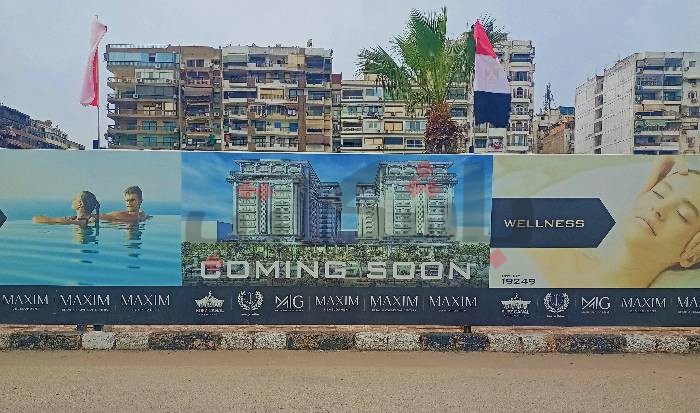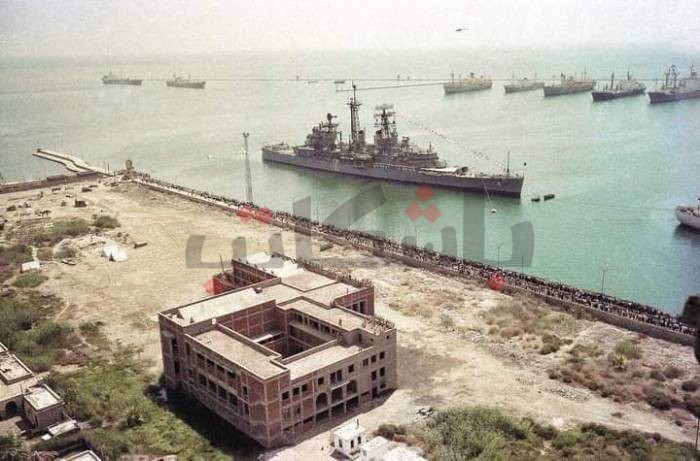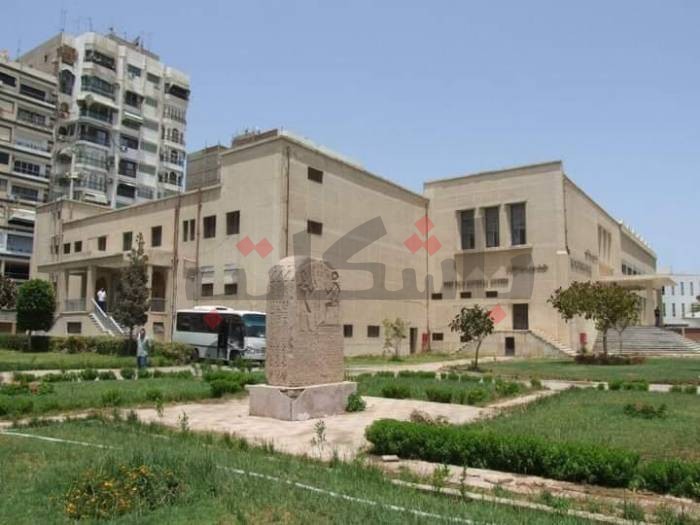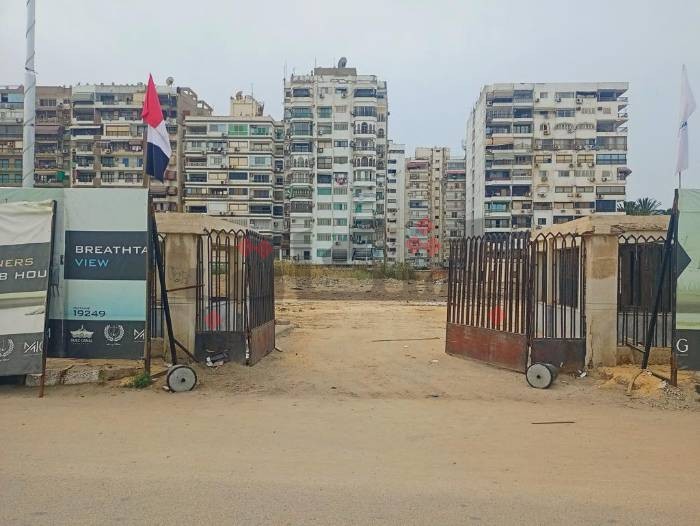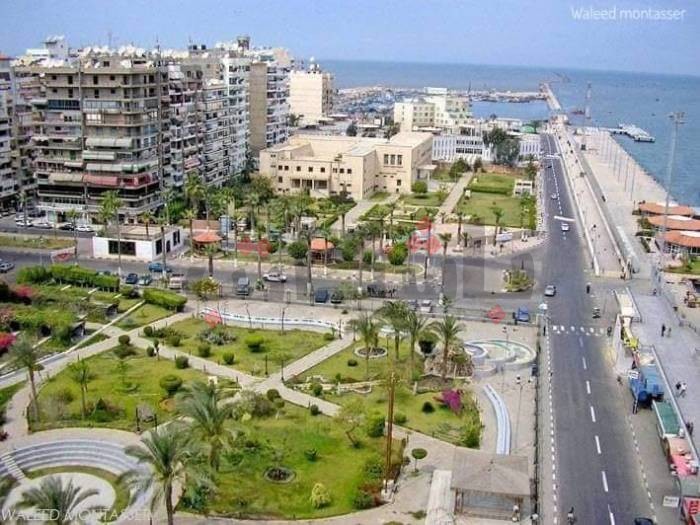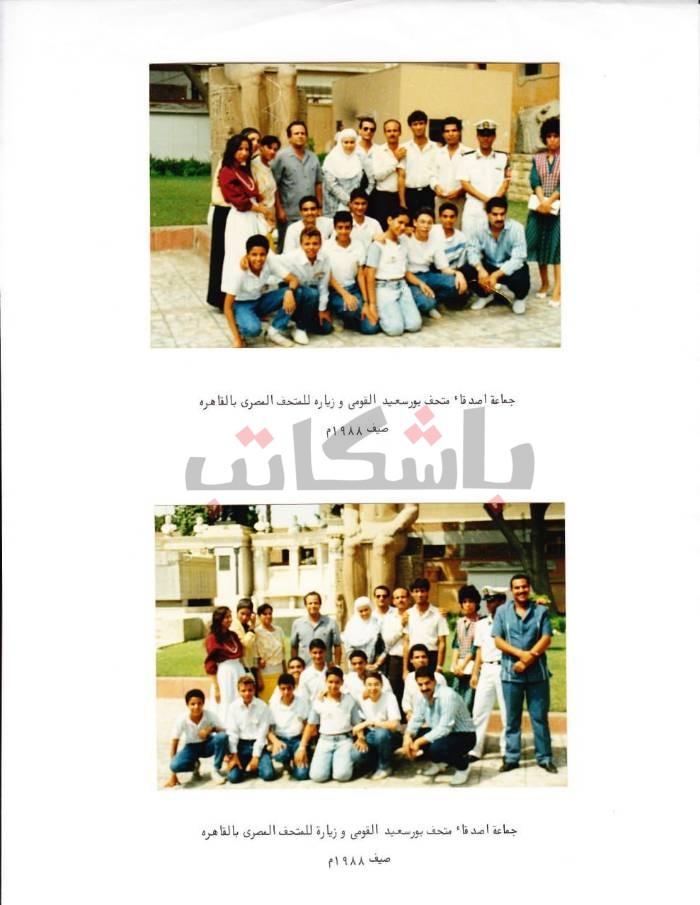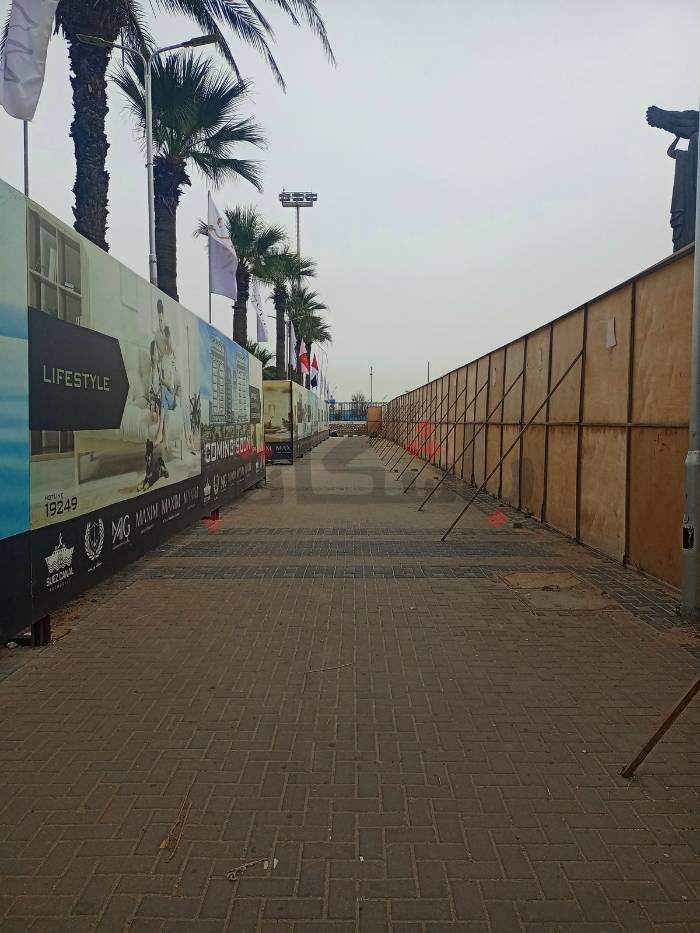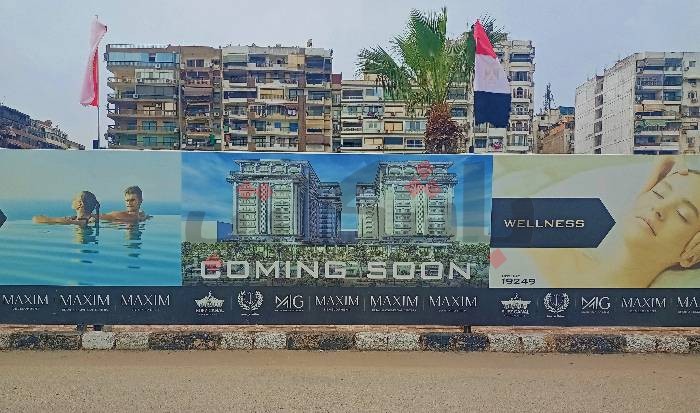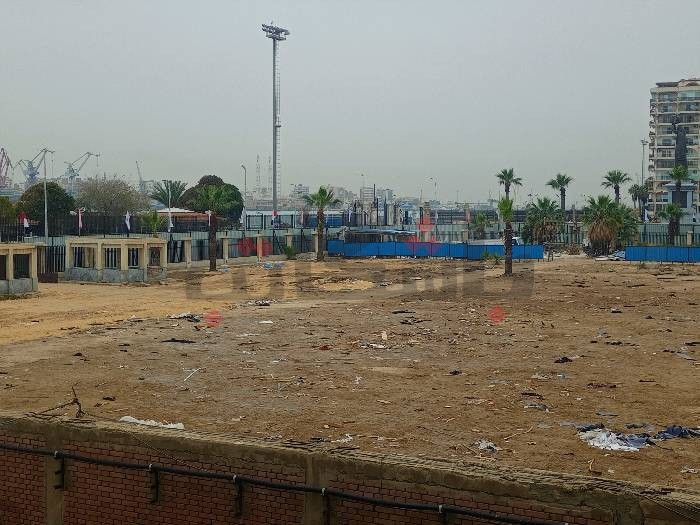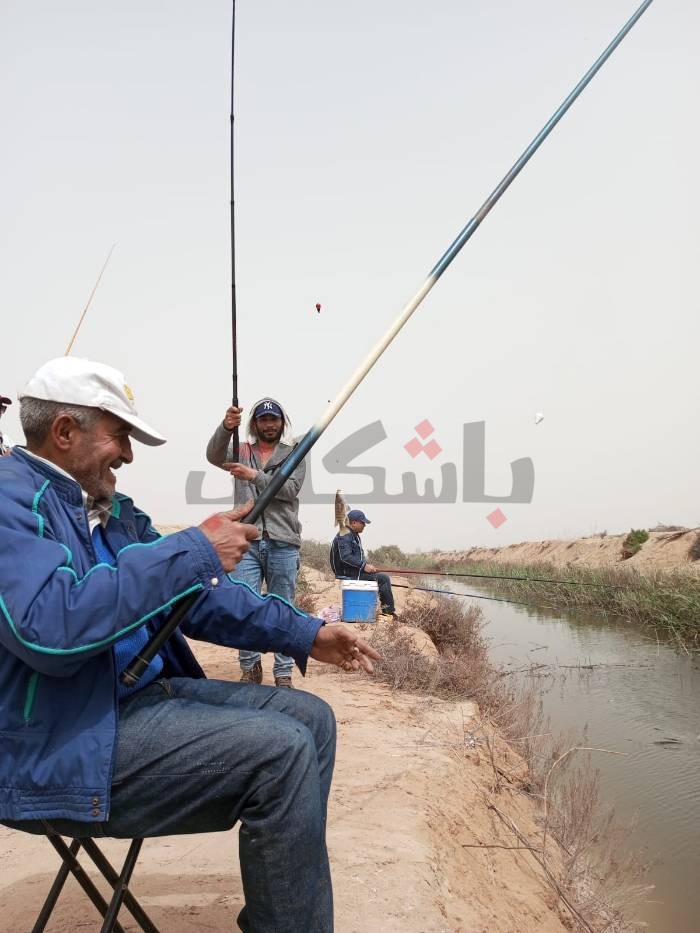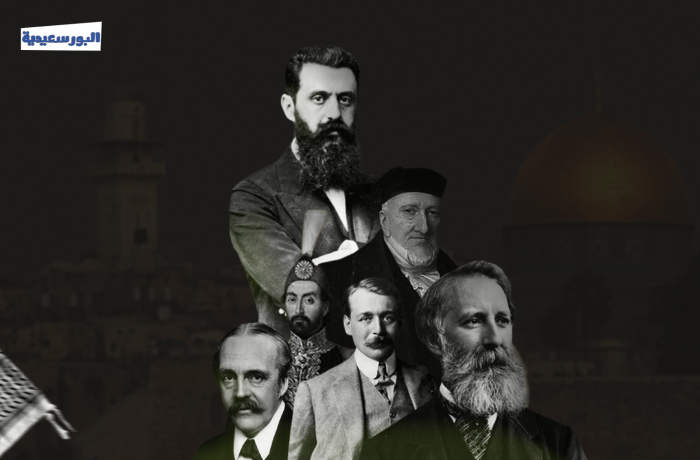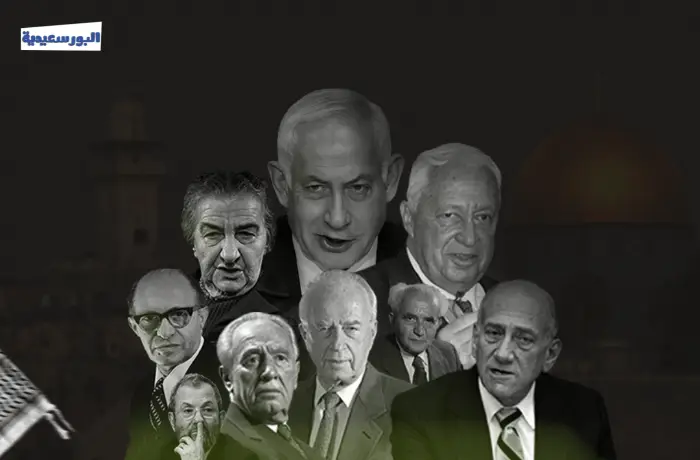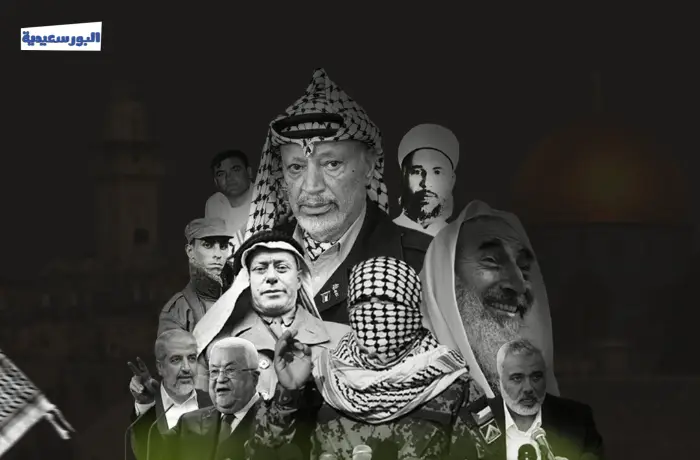Facing the tourist quay of the Suez Canal, designated for passengers of cruise ships at the northern entrance of the canal, is the land of the 'Port Said National Museum.
Two months ago, it was just an empty land except for the remnants of the museum itself, which was demolished in 2010 under the pretext of "development," while its contents—reaching up to 9,000 artifacts—were transferred to the warehouses of the Ministry of Antiquities.

Over the years, government promises have consistently addressed the residents of Port Said and others concerned with the cultural and archaeological heritage of the museum, assuring them that the reconstruction is inevitable and that it is merely a deferred plan awaiting implementation.
All of these aspirations dissipated in February, when the residents of Port Said were astonished by a radically different scene. Signs surrounding the land proclaimed an opulent tourist residential project named "Maxim Canal," adorned with the emblems of the Suez Canal Authority and the Port Said Governorate.
The world turned upside down, and there has been no peace within the governorate since that moment. Activities have unfolded, including conferences and signature campaigns against the project, protests led by the province's deputies to the People's Assembly, and, finally, a lawsuit before the Administrative Judiciary at the State Council. The aim is to halt the decision to allocate the museum's land to a real estate development company and advocate for its return to the Ministry of Tourism and Antiquities.
What is the full story of the Port Said National Museum? And what is the name of the company that appears on the advertising signs? And why do the residents here insist on not giving it up?
The museum's land is situated on "Palestine Street" in front of the renowned Delicesbes Promenade. It stands as one of the oldest national museums, showcasing art pieces that are unique among Egyptian museums. Moreover, it includes a conference hall, a theater, a VIP hall, seven exhibition halls, and an ever-active library that hosts educational and craft workshops. The museum consistently held the fourth position among Egyptian museums in terms of both monthly and annual revenues.
The construction of the museum was undertaken by the late Egyptian President Gamal Abdel Nasser through his decree number 125 of the year 1963. This decree involved the adjustment of the boundaries of the Suez Canal facility and included the incorporation of the area of the museum's land in Port Said, overlooking the entrance of the navigational channel of the Suez Canal, into the assets of Port Said Governorate. Following this, the Local People's Council for the governorate issued a decision to allocate the land to the Ministry of Antiquities for a specific purpose: the establishment of a national museum to showcase artifacts discovered throughout the governorate.
The construction of the museum initially began on a 13,000 square meter area. However, the work came to a halt for 13 years during the Tripartite Aggression in 1965 and the Israeli occupation of Sinai, which is adjacent to Port Said, in 1967. Just before its official opening, the Cabinet added an additional 2,556.7 square meters from land owned by the Suez Canal Authority through decision number 1503, with an official rent of 67 Egyptian pounds annually. This land was intended for services related to the museum.

The Port Said National Museum was officially inaugurated on the National Day of Port Said on December 23, 1986. Finally, an additional area of 2,119.0 square meters was acquired by the Egyptian Antiquities Authority in 1992 from the naval base that was located behind the museum at that time.
In 2009, the Projects Sector of the Ministry of Culture allocated a sum of 75 million Egyptian pounds to initiate the development and redesign of the museum, transforming its facade into the shape of a ship. At that time, Mustafa Abdel-Latif, the governor of Port Said, stated that this development was part of a comprehensive plan to establish a sound and light project depicting the stages of the canal excavation and the development of the Delicesbes base. Indeed, the Port Said Museum was demolished in 2010 with the intention of reconstruction according to the proposed design. However, following the events of the 2011 revolution, the project was halted, and the site turned into an empty land.
As of now, no one knows the fate of the allocated funds for the museum, and there is still no clear answer as to why the reconstruction has not taken place yet. Despite previous presidential directives in 2017 during President Abdel Fattah el-Sisi's visit to Port Said to rebuild the museum in support of tourism, no attention seems to have been given to these directives.
In a memorandum submitted by members of the parliament and the senate in Port Said to Dr. Mostafa Madbouly, the Prime Minister, they inquired about the direct assignment given to the real estate development company to exploit the historical dome of the Suez Canal Authority in Port Said, the land of the Port Said National Museum, and the land behind the Fishing Club directly on the shores of Port Said "without any public announcement." They demanded clarification of the details to establish the principle of transparency.
The advertising signs display the name of the company "Maxim," a private enterprise specializing in the management of hotels and tourist facilities. Established in 1980, Maxim operates in the development, management, and investment across diverse sectors of the real estate market. Furthermore, the company is involved in the construction of residential, hotel, and commercial units.
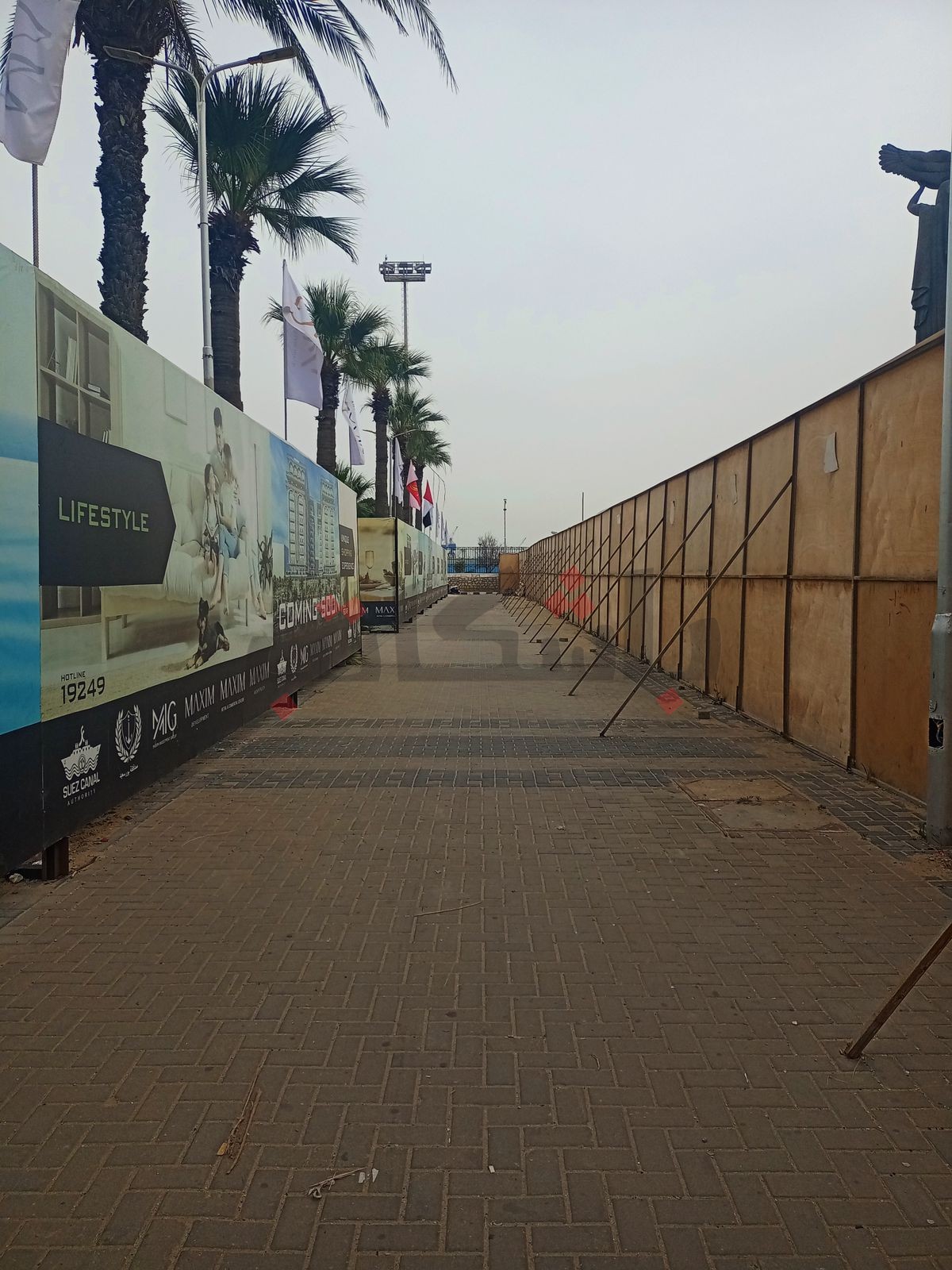
Mohamed Krar, the chairman of its board, announced during a press conference in June 2021 that the company's business volume has surpassed 15 billion Egyptian pounds. The company's land portfolio spans 7 million square meters across diverse areas and sectors, including residential, hotel, administrative, and commercial projects. Krar stated that the company is presently engaged in the development and enhancement of a segment of its land portfolio, with an investment exceeding 5 billion Egyptian pounds in the residential and hotel sectors.
In February 2023, also through a press conference, Mohamed Sameer, the CEO of Maxim Company, announced that the company had won contracts to manage four tourist facilities under a usufruct system. These management contracts included the Civilization Museums in Cairo and Sharm El Sheikh, Lake Ain El-Sira Museum, and the Delicesbes Hotel.
Through social media platforms, Maxim began marketing its project on the museum's land, which includes hotel apartments, a swimming pool, a cafe, a bar, a commercial area, a fitness center, and a car garage.
The price of the smallest hotel apartment in the project, with an area of 180 square meters, ranged from 10 million Egyptian pounds to 20 million Egyptian pounds for a unit with a view of the canal. The delivery is scheduled after 4 years, with an installment plan extending up to 7 years.
What is peculiar about the information published by the company is the absence, until now, of any official decree regarding this allocation. This point is crucial and has been emphasized by Ali Ayyub, the lawyer, in his lawsuit before the Administrative Judiciary at the State Council, where he seeks to halt the decision to allocate the museum's land to Maxim. The issuance of an official decree would mean preventing any legal objection, in accordance with the legislative amendment during Adly Mansour's era, which stipulates that citizens do not have the right to challenge official government decisions under Law No. 32 of 2014.
The lawsuit demands the return of the museum's land to the Ministry of Tourism and Antiquities. It also calls for the formation of a comprehensive committee involving experts from both ministries, including museum curators, restoration specialists, and legal professionals. This committee would be tasked with determining the fate of the 9,000 artifacts that were in the museum. The goal is to assess their current preservation status through registration records, their artistic condition, and to present a detailed report on their whereabouts.
The lawsuit contested both the Minister of Antiquities and Tourism and the Minister of Culture, as well as the Governor of Port Said in their official capacities. In its petition, it stated: "There is a possibility of losing some of the artifacts in the museum or their smuggling abroad, affecting their artistic value due to poor preservation."
The installation of signs for the proposed residential project on the land of the Port Said Museum did not pass unnoticed. Since its discovery on the first day, there have been proactive efforts from the residents of Port Said to try to stop the project, viewing it as a "nightmare." Initiatives included events like the Lawyers Syndicate conference, attended by various cultural, intellectual, and political leaders, as well as the launch of a campaign to gather signatures against the project, intending to send them to the President.
The residents of Port Said communicated with Dr. Mona Sabeh, the General Director at the Ministry of Antiquities in Port Said. She mentioned that the budget for the development of the museum was already allocated in 2010. However, after the January 2011 revolution, a fire broke out in the Egyptian Islamic Museum in Cairo. The ministry then decided to allocate the budget for its development first before the Port Said Museum.
The dossier for the museum's development got lost amidst ministerial changes, with former ministers of antiquities citing a budgetary constraint as the reason. In 2021, Dr. Khaled El-Enany, the former Minister of Antiquities, announced the government's intention to establish a global hotel project attached to the National Museum, adhering to international standards. The only hindrance he faced was also financial. However, the ministry has currently abandoned the idea, as explained by Mona, who justifies it by claiming that the current officials overseeing the ministry are neglecting the historical significance of the museum.
She continues: "In 2019, when one of the security personnel, accompanied by individuals from the Suez Canal Authority, came to the museum's land demanding control, Sabah Muslim, appointed by the Ministry of Antiquities as responsible for the museum's land, expelled them and prevented them from entering the premises."
Mona points out that one of the issues with the museum is that the ownership of the land is divided among the Suez Canal Authority, the Port Said Governorate, and the Ministry of Tourism and Antiquities.
She adds: "Up to this moment, my friends from various nationalities still reach out to me, expressing their desire to visit the National Museum of Port Said. However, each time I have to inform them about the demolition of the museum."
The Port Said Historical Association leads the opposition to the transformation of the museum's land into a commercial project. Ayman Gabr, its founder, expresses to "Al-Port Saidia," saying: "Museums are not just places where artifacts and artistic and archaeological works are exhibited and preserved, but they are centers of enlightenment, culture, and knowledge, playing a leading role in strengthening the creative economy on both the local and global levels."
Monica Hanna, the Dean of the Faculty of Antiquities and Cultural Heritage at the Arab Academy for Science, Technology, and Maritime Transport in Aswan, posted on her Facebook page about the importance of the land of the Port Said National Museum, saying: "Why is the museum important to us, like the axis and the bridge?"
And she explains to "Al-Port Saidia": "The real infrastructure is the network that conveys individuals and consequently ideas and experiences."
She adds: "The establishment of the first museum is fundamentally an Egyptian idea, and the first museum in history is the ancient Library of Alexandria. After that, museums evolved from the 19th century in Europe, becoming symbols of progress for nations."
She adds: "Since 1952, there has been political and popular will to establish regional museums in Egypt as a reaction to colonialism. However, today, the spaces of these museums are eroding due to the absence of public policies to manage this important heritage."
On the other hand, "Al-Port Saidia" continues to communicate with Islam Abdel Meguid, a lawyer at the Court of Cassation and a former member of the Local People's Council for Port Said Governorate, and one of the founders of the popular campaign to defend the land of the National Museum. He explained that the campaign seeks to reclaim the museum's land for its reconstruction.
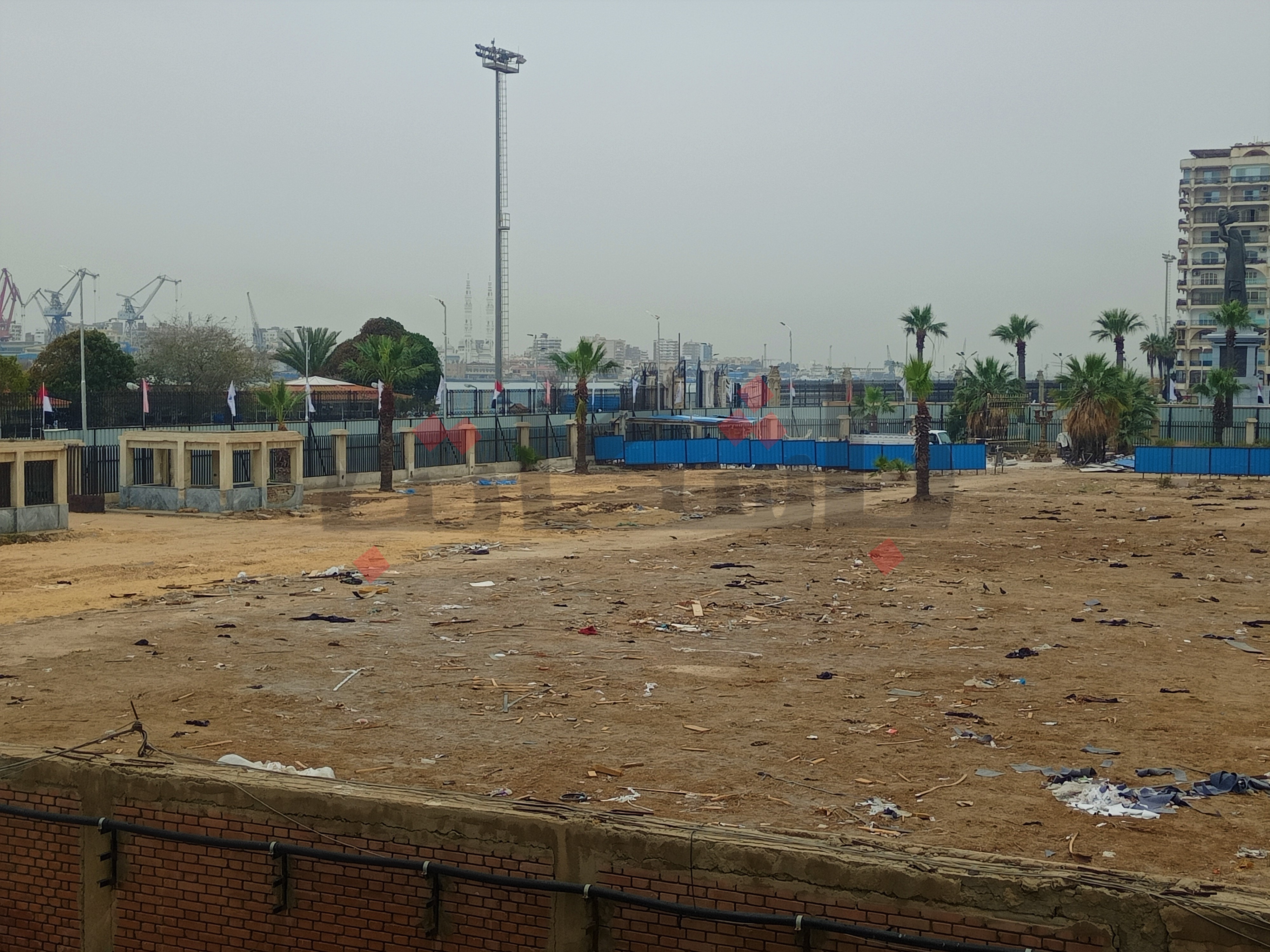
The campaign's statement addresses what it calls "the security dimension" in diverting this land for another purpose, citing its unique location at the entrance of the navigational channel. The statement also rejects the presentation of a residential project that would only benefit its residents, instead of completing a project that preserves the identity and visual memory of Egypt.
